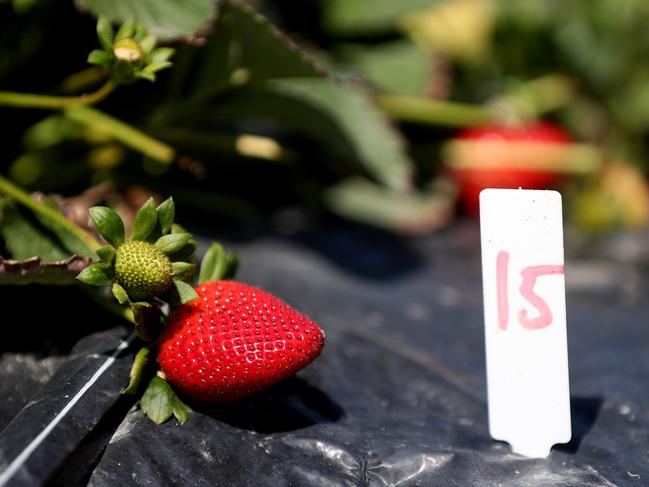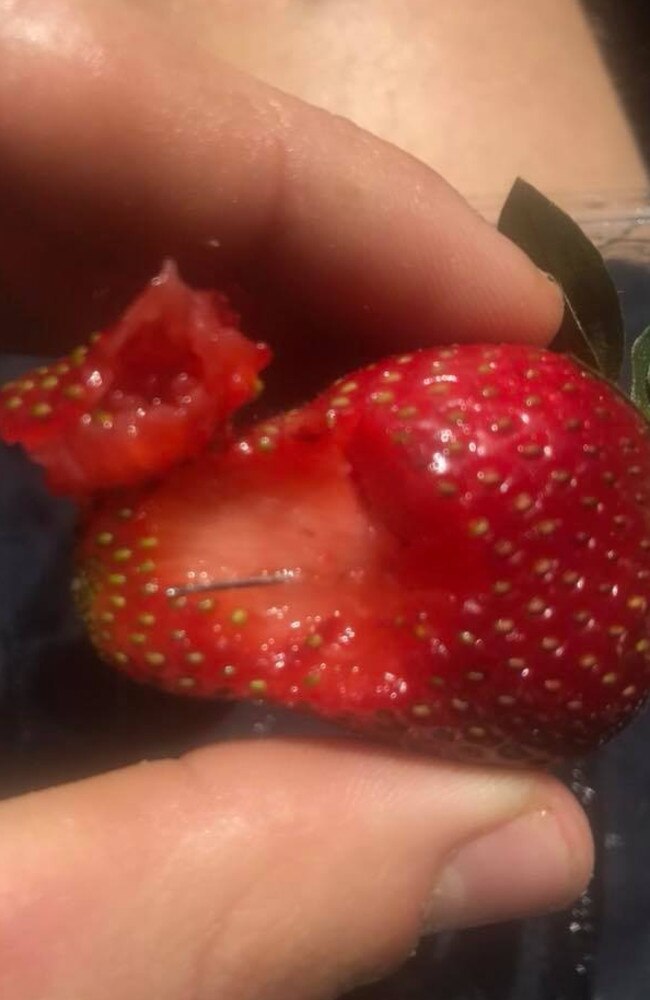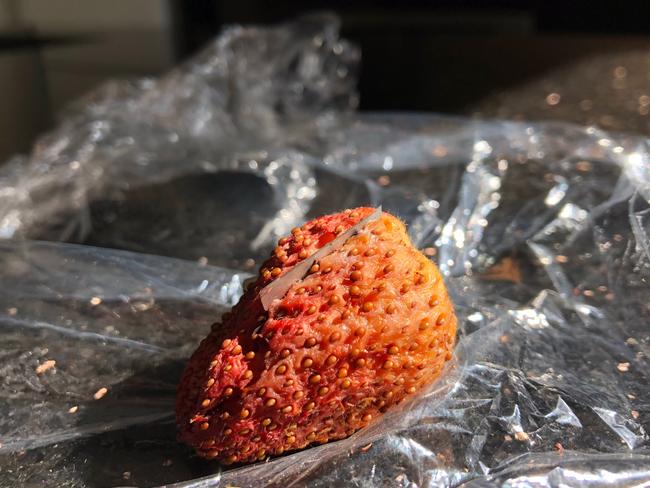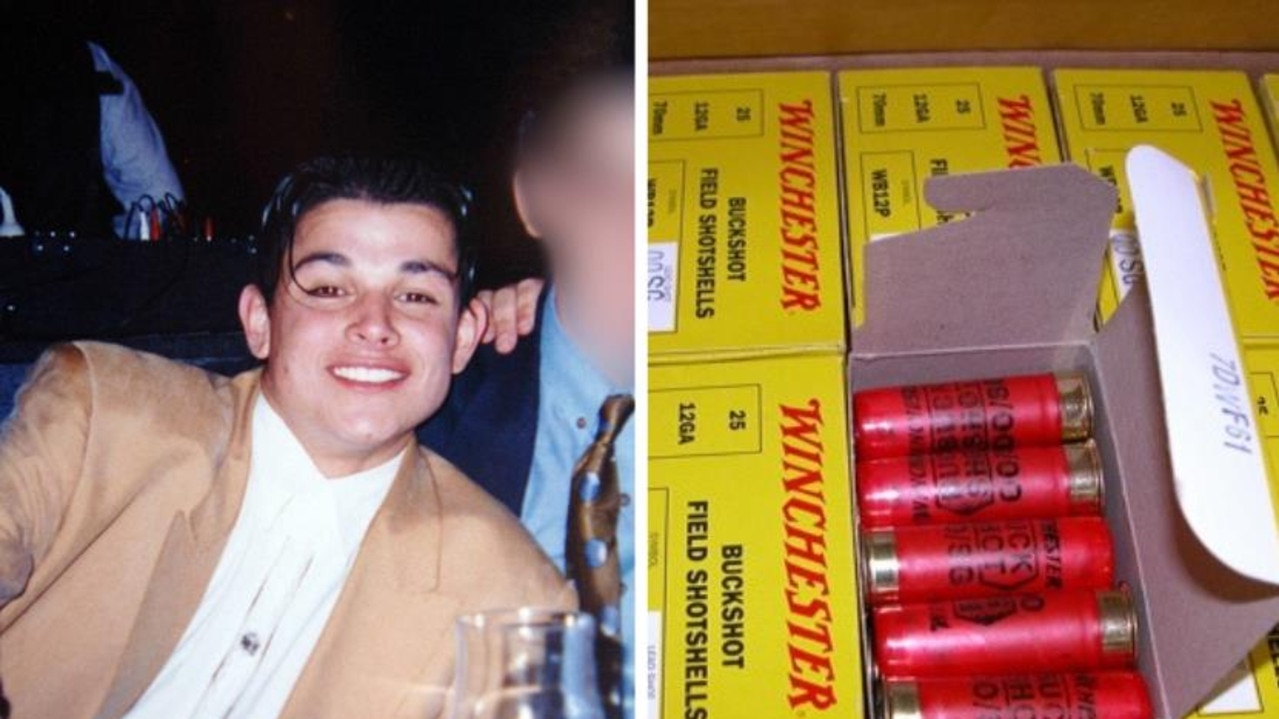Strawberry contamination: Why do people commit copycat crimes?
IT started with needles found in strawberries packed by two brands. It’s exploded to more than 100 incidents of ‘spiked’ fruit. Has the uproar inspired a wave of ‘copycats’?

Behind the Scenes
Don't miss out on the headlines from Behind the Scenes. Followed categories will be added to My News.
THE young NSW schoolgirl rushed to show her friends: look, a needle! For a moment the 12-year-old was the centre of attention. It was a near miss. Wow, this national strawberry spiking crisis had struck here!
Police were contacted after another student at the Blue Mountains school passed the story on to teachers.
The startled girl was interviewed at home. She insisted she didn’t know how the needle had got into her snack.
Only after the police left did she crack, and confess to her parents it had all been an attention-getting prank.
The officers were called back to get the true story.
It’s just one example. But it could help explain how the spiking of a few punnets of strawberries has exploded into a national crisis.
No suspect has been identified. No motive has been established.
Yet, over the space of just two weeks, the health scare has ballooned to well over 100 cases nationally, and extended to apples and bananas.
“What isn’t helpful is the number of copycat and fake reports making an already difficult situation worse,” Queensland Premier Annastacia Palaszczuk said. “This is something with which the growers have expressed their anger and frustration and I couldn’t agree more. The people copying this crime are in many ways worse than those who started it.”
Now, the federal government has been spurred to act: Anyone who tampers with food could soon face up to 15 years’ jail, in line with child pornography and terror financing offences.
So who would take such risks?

OPPORTUNITY KNOCKS
Senior Lecturer at the Faculty of Law of Queensland University of Technology Dr Claire Ferguson says that despite claims of copycat behaviour by government and police, this is yet to be firmly established.
“With regard to the ongoing fruit tampering in Australia, it has yet to be established if different people are responsible for the crimes, though the geographically widespread nature of the cases makes it unlikely that a single individual or group is responsible,” she writes in The Conversation.
And Dr Ferguson says that, because of the risk of injury and publication to rare food-tampering cases such as this, actual incidents are unlikely to go unreported.
“And if more than one person is involved, the (prospect of copycat crime) might be assumed due to the media saturation of stories about sabotaged strawberries.”
Nationals frontbencher Andrew Broad has blasted the culprits as “low-life scum”. Coles and Aldi supermarkets have pulled all strawberries from their shelves, except Western Australia, as a precaution.
But such news reports can act as a catalyst to tendencies already present in offenders, Dr Ferguson says.
“The underlying motivations are therefore likely to be as various as general criminal motivations, including revenge, thrill, hatred, concealment of other criminality, material gain or jealousy. In the case of alleged copycat food tampering, this means that motivations would differ from perpetrator to perpetrator.”

CONTAGIOUS IDEAS
While media reports can lead to criminal behaviour being copied, Dr Ferguson says researchers agree these are unlikely to actually cause criminality.
She describes the phenomenon as more of a ‘contagion effect’ than pure copycat behaviour, “although the public tends to use these descriptors interchangeably”.
“Someone who wasn’t already motivated to commit a crime wouldn’t suddenly become motivated to do so just because he or she saw something in a newspaper. A contagion effect is therefore rare.”
What is contagious, she says, is the idea.
Copycat crimes can be spurred by fictional stories as well as news reports, Dr Ferguson says.
“For example, at least three spree killings committed by young couples around the world have been linked to the film Natural Born Killers,” she says. “The couples used methods similar to those in the movie and provided justifications similar to those of the fictional offenders.”
Criminologist and psychologist at Melbourne’s RMIT University, Dr Michelle Noon says: “media coverage is giving people an idea of what crime to commit - not the reason or the motive to commit crime full stop.”
Queensland Police, for example, are investigating after a 62-year-old woman was caught sticking a needle into a banana in a shop in Mackay, in an apparent copycat act. The woman, who is understood to have mental health issues, was given a warning and referred to support services.
Dr Noon told news.com.au that copycats would often tell themselves they had every reason to do what they were doing. They use distorted thinking to develop rationales to justify their behaviour.
“For them, they might say, ‘They made me do it, I was angry.’ What sits underneath the motives is really interesting.
“They’re motivated individuals who have normalised deviant and criminal scripts and behaviours for themselves. Those scripts are gained from peer interactions and explain a preparedness to commit criminal acts.”

FERTILE MINDS
The underlying cause of copycat crime is yet to be understood, making it difficult to predict what events could spark an outbreak.
“Everybody’s different. They could be young or old,” she said. “They could be personally connected or not. They could have a history of criminal behaviour or not. It makes it hard to predict ‘whodunnit’,” Dr Noon says.
And this has serious implications for the future of Australia’s strawberry industry, says Dr Ferguson.
“If copycat fruit tampering is happening in Australia, it is likely to persist or even increase for a period of time until someone is caught or the media saturation dies down,” she says.
But there are clues about those most likely to be copycats.
“There appear to be some personal characteristics that make people more prone to copycat behaviour,” Dr Ferguson says.
People who have an unusual interest in crime reporting and who use video games and the internet far more than television, radio or books appear to show a greater tendency to commit the act.
“Other factors also include low self-control, high innovativeness, disinhibition and a propensity for sensation-seeking,” she says.
But the motive is usually individual.
“Someone may be motivated by a desire to exact revenge on employers or ex-employers. Their motivation might be to make a political statement about the rights and treatment of farm workers, to conceal another crime, to profit financially by suing fruit companies or supermarkets, to gain attention or bragging rights, or perhaps, because of the excitement the behaviour involves.”


